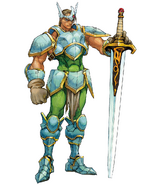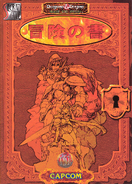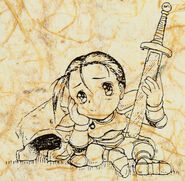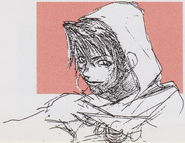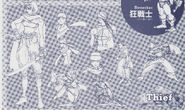Dungeons & Dragons: Shadow over Mystara (ダンジョンズ&ドラゴンズ シャドーオーバーミスタラ) is an arcade beat 'em up game developed and published by Capcom in 1996. It is a sequel to Dungeons & Dragons: Tower of Doom,[1] and the second and final Capcom-developed game based on the Dungeons & Dragons tabletop role-playing game franchise. Like the previous game, Shadow over Mystara is set in the Dungeons & Dragons campaign setting of Mystara.

Character select.
Combining the side-scrolling gameplay of a beat 'em up with some aspects found in a role-playing video game, Shadow over Mystara has many game mechanics not commonly found in arcade games, such as finding and equipping new gear and earning new spells as the player gains experience. Players can wield a large variety of weapons and armor, although this selection is limited by the character the players chooses; there is also an extensive assortment of magical and hidden items in the game, many of which are completely unknown to exist to the typical video gamer. This, along with the addition of multiple endings and forking paths, gives the game much re-playability and has led to a cult following among fans of the genre.
It was one of the last 2-D arcade side-scrollers created by Capcom; only Battle Circuit (1997) came after Shadow over Mystara. It was one of the very few CPS-2 games that allowed for interlinked boards and controls for simultaneous display over two monitors, supporting up to 4 players in one game instance.
The game has seen two home releases as part of the compilations: Dungeons & Dragons Collection published for the Sega Saturn in 1999, and Dungeons & Dragons: Chronicles of Mystara made available on the Nintendo eShop, PlayStation Network, Xbox Live Arcade and Steam in 2013.
Gameplay[]

Art by Kinu Nishimura.
In addition to the original four heroes found in its predecessor, Dungeons & Dragons: Tower of Doom (Cleric, Dwarf, Elf and Fighter), Shadow of Mystara adds a Thief and a Magic-User to the selection. Furthermore, with the inclusion of two separate versions of each character's sprite set, the game allows up to two players to select the same character (in Tower of Doom each of the characters could only be selected once), effectively giving the game 12 "different" characters to choose from. The two Clerics and two Magic Users also have subtle differences within their spell books.
The controls use four buttons: Attack, Jump, Select (brings up a small inventory ring around the character allowing the player to choose what item is set in the Use slot) and Use. The Cleric, Elf and Magic-User also have two extra rings for their spells, with the Jump button used to switch from ring to ring. While the game uses the same kick harness as the previous game, the Select and Use buttons are reversed.
Shadow over Mystara also introduced a selection of special moves which are executed by moving the joystick and tapping the buttons in certain combinations, in a way similar to the Street Fighter series. The characters (except for the Magic-User) have a Dashing Attack as well as a Rising Attack which can be used to combo monsters or even juggle them in the air. Most characters (again, with the exception of the Magic-User and also Cleric) also have a Megacrush, a move common to nearly all of Capcom side-scrollers, which damages all enemies standing close enough to the character but in turn also damaging the player themselves.
Players, as they fight their way through each level, will come across an assortment of treasure. Treasure is found in chests, stolen from monsters, dropped from dead enemies and bosses, or even found simply lying on the ground. Most treasure is gold and silver, which is used to buy simple items in shops (see below), or precious gems, which add to a heroes experience points. Other treasure include weapons and equipment. Treasure on the ground is picked up by standing near it and pressing the Attack button. Due to this feature, characters that stand too close to loot while fighting will instead bend down and retrieve the nearby item. It was very difficult to fight monsters in room full of treasure in Tower of Doom, and Capcom addressed these complaints with the addition of sliding. This maneuver allows players to automatically pick up any treasure and equipment a hero slides over, quickly clearing the area of items.
The game offers a small selection of arcane magic, available for the Magic-User and Elf, and divine magic, available to the Cleric. Instead of an MP system, characters use D&D's Vancian magic system where a certain amount of each spell ready to cast. Extra uses of the spells can be picked up off the ground, represented graphically as scrolls of paper, or occasionally recharged after certain boss fights. When a spell is cast the entire game is momentarily paused during which the spell effect is played out (some spells can be controlled during this time).
Every character starts with their armor (the second slot) already filled, specific to their character, and remains unchanged the entire game. The character's helmet (the first slot) and shield (the fifth slot) are the other two items that lend to a character's defensive ability. Most characters also begin with a shield, except the Magic-User and Thief, who cannot use shields. While magical items in traditional D&D rules are practically invulnerable or tough, the magical items in Shadow over Mystara are very fragile. Magical boots (slot three), gauntlets (slot four), and rings (slot six) are all destroyed after the player is damaged a few times. The eighth slot is used for miscellaneous items, such as the "Skin of the Displacer Beast" or the "Eye of the Beholder"; many bosses drop rare items such as these and they either grant special abilities or can be traded in for special magical equipment. There are also many unique hidden items (for example, hidden near the end of the game is a treasure chest which contains the Staff of Wizardry when opened by the Magic-User: if the Magic-User wields the staff during the final boss fight and there are at least three players with a combined total of over 1 million experience points, the Staff will glow and the team will be able to use the powerful Final Strike attack).
In between many stages the players find themselves inside small town stores where they can restock on common items such as arrows, burning oils, throwing daggers and healing potions. Players can sell items for gold and also trade special items found during boss battles with shopkeepers (by clicking on the shopkeepers head) to earn unique magical items. The players can also come across a special gnome village where the townfolk beg to be saved from a chimera (the gnomes, unlike traditional Dungeons & Dragons gnomes, are very minuscule, standing about a foot tall).
Shadow over Mystara contains a system which allows the players to name their characters. Abusing this system using methods involving typing a space as the first character of the name, followed by a long string of repeated letters, cause the game to become incredibly glitched, giving the players powerful items in the beginning of the game. This exploit also has a nasty side effect of causing the game to have an incredible amount of visual bugs (flickering sprites, missing sprites and mistakes in the text) and often causes the game to reboot, or worse, to freeze up. Arcade owners, unaware that the players themselves were the cause of the troubles, would often shut down the machine for repair or simply remove the game completely. Gamers on the Internet, aware of these consequences, would often refuse to post instructions on how to activate the glitch. Revision 2 of the game prevented the use of this bug.
A less dangerous glitch, known commonly as "Highlander Mode", allows the Magic-User and Thief to become more or less immune to all damage. Players must simply swap their default headgear to use the exploit—any Magic-User wearing a Hood (the Thief's default hat) or any Thief that wears a Magician's Hat (the Magic-User's starting hat) cannot be killed from any standard damage in the game (the character will be reduced to 1 hit point but will not be killed). Some examples of non-standard damage that can still drop the player below 1 hit point are bite attacks, breath weapons, treasure chests thrown by allies, and spells. This bug was never addressed in the arcade.
Plot[]
After defeating the Arch Lich Deimos, the heroes continued on their journey through the Broken Lands of Glantri after realizing that Deimos is only part of an even greater evil plan, and he was in fact being used by a mysterious sorceress named Synn. Synn, who appears to be a young woman but commands incredibly powerful magical abilities, has been scheming to control the Kingdom of Glantri and conquer the humanoids of the Republic of Darokin. But now that Deimos has been defeated, Synn vowed to punish the land that she desired.
At the game's end the player discovers that Synn is in fact a centuries-old huge red dragon, bent on harnessing the mystical forces of the lands she has conquered, in order to awaken a creature of even more devastating physical prowess than herself - known and described only as The Fiend. The heroes then fight against Synn in her lair; when she is slain, her monster is also destroyed by airship bombing.
After the heroes beat the final boss, each member of the group is treated to a short epilogue detailing his or her future exploits. Endings are titled with a simple code: the first letter of the character class followed by the number of the ending. Therefore, the Cleric's second ending is called "C-2", the Fighter's best ending is named "F-1", and so forth. There are four separate endings per character class and the hero earns an ending based on multiple factors that are specific to the character's class above ?-3 endings. With the exception of the Dwarf and Cleric, characters can receive a ?-3 ending if they have collected at least 3000 SP. All character classes have a message based on having struck the final blow to Synn, but it is not always their ?-1 ending. Several classes have endings based on beating the game while wielding a weapon or simply having it in their inventory, including the Battle Axe, the Sling, or the Sword of Legend, among others. Higher numbered endings can be achieved without meeting the requirements for lower numbered endings.
Characters[]
- Cleric (default name Greldon/Miles[2]) - The Cleric's role is to be the party's healer and buffer, but he is also a formidable warrior, possessing the best rushing attack in the game. He also has the ability to turn undead, instantly destroying skeletons and ghouls, and can cast from a large library of clerical spells that can heal, strengthen allies, and debilitate or damage enemies. In line with classic Dungeons & Dragons rules, the cleric cannot wield any weapon that is bladed; however, he can wield a spiked morningstar from which he gains new special attacks.
- Dwarf (default name Dimsdale/Hendel[2]) - The Dwarf is a hardy character that has the most hit points in the game, and is able to deal the most physical damage in a short amount of time. His short stature allows him to safely pass under enemy projectiles. The Dwarf has strengths that lie in his special attacks rather than his normal attacks; he also has the unique ability to bash opened treasure chests to reveal extra gold and treasure.
- Elf (default name Lucia/Kayla[2]) - The Elf is a female fighter-mage, combining the offense of a Fighter with the spells of a Magic-user. Although her capabilities in such are less powerful than that of the Fighter and Magic-User respectively, she remains a versatile and useful character. Her disadvantages are her low constitution and defense, and the shortest melee weapon reach in the game; the Elf's attack hitbox remains the same and is not improved even when using weapons longer than her default short sword. Much like the Dwarf, she reaches her maximum level fairly early in the game, which gives her an early advantage but just as well halts her progression abruptly and reduces the effectiveness of consumable magic items such as the Bottle of Efreet.
- Fighter (default name Crassus/Jarred[2]) - The Fighter is a melee character with an excellent moveset, long weapon reach, high endurance, and the best armor class, making him suitable for beginners and experts alike. He can wield nearly every weapon in the game, including the two-handed sword, and is the only character with the ability to dual-wield with a short sword in his offhand. The Sword of Legends item in the game is named after the highest ranking Fighter in the high scores.
- Magic-User (default name Syous/D'raven[2]) - The Magic-User is a master of devastating spells but is physically the weakest character in the game; as such, he is quick to die when played by novices due to his low constitution and relatively weak melee abilities. To offset his low amount of health, the Magic-User has a useful teleportation move which allows him to dodge all physical attacks (and can be used to perform elaborate and damaging combos by experienced players), along with a spell that grants him temporary invulnerability. The Magic-User is a difficult but rewarding character to use that requires previous knowledge of the game and effective management of his spells. His offensive spells are greatly enhanced by the Staff of Wizardry, arguably making him the most powerful character in the game.
- Thief (default name Moriah/Shannon[2]): The female Thief is a quick and dexterous warrior with many unique acrobatic skills, such as a double jump, wall jump, back flip, and leap across the screen. She has the abilities to pick locks, detect traps, pickpocket enemies, and even backstab enemies for severe damage. The Thief also has an unlimited supply of rocks to sling with and utilizes flasks of burning oil in some of her special attacks. However, she suffers defensively due to her moderate constitution and lack of a shield. The Thief has the highest maximum level in the game and thus benefits the most from consumable magic items, such as the Bottle of Efreet, that increase in effectiveness with the character level.
Players, upon completion of their first stage, are prompted to enter a character name. Unlike many games at the time which only allow a person to enter three letters, Shadow over Mystara has space for six. The game provides a default name for each of the characters; the default name is also automatically used if the player tries to submit a blank name or use vulgarity.
Release[]
The arcade version of the game was released in 1996. The guide/art book was published by Shinseisha in the Gamest Mook series that same year.[3]
Dungeons & Dragons Collection[]
In 1999, Capcom compiled both D&D arcade games as Dungeons & Dragons Collection, released for the Sega Saturn in Japan only. Although, graphically, the games are basically identical to their arcade counterparts, due to the limitations of the Saturn there is a maximum of two players instead of the original four. Furthermore, there are minor modifications to many areas of gameplay, such as changes in spell damage and the removal of certain software bugs.
Dungeons & Dragons: Chronicles of Mystara[]
Capcom announced at PAX East 2013 that they would release Tower of Doom and Shadow over Mystara as part of the Dungeons & Dragons: Chronicles of Mystara HD compilation on Nintendo eShop, PlayStation Network, Xbox Live Arcade and Microsoft Windows.[4]
Reception[]
A preview in VideoGames praised the game's "astounding" graphical details and called it "Capcom's latest masterpiece".[5] On release, a reviewer for Next Generation said it "is full of the stuff that made the first so fun." He further said that the game had refined Dungeons & Dragons: Tower of Doom, improving the animation quality to X-Men: Children of the Atom level, expanding the number of playable characters, adding more stage branches and endings to create deeper gameplay and story, and incorporating more interesting character abilities such as wielding two swords. Despite this, he gave it only three out of five stars.[6]
According to GameSpy in 2004, "Shadows Over Mystara was a stellar game back when arcades were still a good place to find the hottest games. And it's still fun today."[7] In 2011, GameSpy ranked it #50 on their list of the top arcade games, calling it "one of the most purely entertaining titles ever released for any platform."[8] In 2013, it was ranked as the 18th top beat 'em up video game of all time by Heavy.com,[9] and included among the best looking beat 'em up games from the 16-bit era by Kotaku.[10] Retro Gamer ranked it as the 16th top retro arcade game.[11] IGN ranked Shadow Over Mystara No. 9 on their list of "The Top 11 Dungeons & Dragons Games of All Time" in 2014.[12]
Credits[]
Planner: Kenkun Kataoka, Malachie
Character Design: Kinu.Nishimura
Object: "s" Is a Criminal, H.Minobe, Shinya.M, Dway Nishimura, Kanako.Takami, Miwa Shigenaga, Toshihiro Suzuki, Kako, Masayo.Tsujimoto, T.Shirahama, Ino, R.Sato, Sa Ga Ta, M.Kondo, Shinz.Sakashita, S.Yamashita, Y.Yamamoto, Dja, Jon, Inukichi Iwasaki, Jun Mathumura 28
Scroll: Nissui, Saru, Shake, Hisoya, S.Kuwatch, J.Son, Ojiji, Takky, Iwai, Meiko.K
Music Compose: Masato Koda
Sound Design: Moe.T
Sound Effect: Moe.T, Hachi Bee, Satoshi Ise
Sound Produce: Arcade Sound Team
Thanks to: Lee, Mta (groovy) Nshi
Programmer: O G T, Kazuo.Yamawaki, Motsu, Tora & Yume & Hide, Ryota Forever, K A T S U O, Knishi-MadDogMc
Special Thanks: Shinichi Yasuki, Mr. Shiraiwa
Original Script: Alex Jimenez
Special Thanks (continued): Capcom All Staff, and You
Presented by: Capcom
Gallery[]
Characters[]
Advertisements and Merchandise[]
Gamest Mook Guidebook[]
Miscellaneous Artwork[]
Videos[]
Trivia[]
- The Thief's character design is strikingly similar to Mariah, a character from the manga and anime series JoJo's Bizarre Adventure. This would come full circle with the release of the arcade game based on the series in 1998-1999, with Mariah appearing in the second game of the series.
References[]
- ↑ http://www.arcade-museum.com/game_detail.php?game_id=7667
- ↑ 2.0 2.1 2.2 2.3 2.4 2.5 Default name playing with second version of this characters.
- ↑ https://web.archive.org/web/20140131102136/http://www.arcade-gear.com/Games/Dungeons_and_Dragons_Shadow_Over_Mystara/Dungeons_and_Dragons_Shadow_Over_Mystara.htm
- ↑ http://www.gamespot.com/news/capcoms-dungeons-and-dragons-collection-confirmed-6405781
- ↑ VideoGames (April 1996) page 67.
- ↑ cite magazine|last=|first= |title=Dungeons and Dragons 2: Shadow over Mystara |magazine=Next Generation|issue=16 |publisher=Imagine Media|date=April 1996|pages=98, 101
- ↑ http://uk.ign.com/articles/2005/06/14/game-help-editors-picks-co-op-games
- ↑ http://uk.gamespy.com/articles/115/1151159p2.html
- ↑ http://www.heavy.com/entertainment/2013/05/the-top-25-beat-em-up-video-games-part-1//
- ↑ http://www.kotaku.com.au/2013/03/the-best-looking-beat-em-up-games-from-the-16-bit-era/
- ↑ Retro Gamer 54, page 64.
- ↑ http://www.ign.com/articles/2014/02/05/the-top-11-dungeons-dragons-games-of-all-time
External Links[]
- FantasyAnime's D&D section - covers both D&D video games with full character bios, multimedia downloads, and an interview with one of the developers.
- JonC's Shadow over Mystara page - this fansite has a full guide as well as pages discussing and extolling the game's features.
- Shadow over Mystara Shrine - game guide at RPGClassics.
- Gamest Mook Guidebook - complete scan at archive.org.




